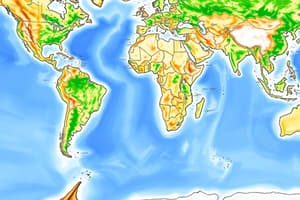Podcast
Questions and Answers
What is the primary focus of Physical Geography?
What is the primary focus of Physical Geography?
- Analysis of environmental issues
- Study of human activities and cultures
- Technology for managing spatial data
- Natural features and processes of the Earth (correct)
Which component is a part of Human Geography?
Which component is a part of Human Geography?
- Soil types
- Population Geography (correct)
- Hydrology
- Climate Change
Which key component is concerned with environmental issues in Environmental Geography?
Which key component is concerned with environmental issues in Environmental Geography?
- Wetlands performance
- Rural economics
- Sustainable development (correct)
- Urban planning
What role does Geographical Information Systems (GIS) primarily serve?
What role does Geographical Information Systems (GIS) primarily serve?
Which of the following is NOT a component of Physical Geography?
Which of the following is NOT a component of Physical Geography?
What aspect of Human Geography focuses on the spatial arrangements of cities?
What aspect of Human Geography focuses on the spatial arrangements of cities?
The study of climate change falls under which area of geography?
The study of climate change falls under which area of geography?
Which of the following techniques is NOT associated with Geographical Information Systems?
Which of the following techniques is NOT associated with Geographical Information Systems?
Flashcards are hidden until you start studying
Study Notes
Physical Geography
- Definition: Study of natural features and processes of the Earth.
- Key Components:
- Landforms: Mountains, valleys, plateaus, plains.
- Climate: Weather patterns, atmospheric conditions, climatic zones.
- Biogeography: Distribution of ecosystems and species.
- Hydrology: Study of water bodies, rivers, lakes, and groundwater.
- Soils: Soil types, formation processes, and distribution.
Human Geography
- Definition: Study of human activities, cultures, and their relationship with the environment.
- Key Components:
- Population Geography: Distribution, density, and demographics of populations.
- Cultural Geography: Language, religion, traditions, and cultural landscapes.
- Economic Geography: Resources, industries, trade patterns, and economic activities.
- Urban Geography: Study of cities, urbanization, and spatial organization.
- Political Geography: Territoriality, borders, and governance systems.
Environmental Geography
- Definition: Intersection of physical and human geography focusing on environmental issues.
- Key Components:
- Environmental Change: Impact of human activities on natural environments.
- Sustainability: Concepts of sustainable development and resource management.
- Conservation: Protection and management of natural resources and ecosystems.
- Climate Change: Effects on landscapes, ecosystems, and human societies.
- Environmental Policy: Laws and regulations aimed at protecting the environment.
Geographical Information Systems (GIS)
- Definition: Technology for capturing, storing, analyzing, and managing spatial and geographic data.
- Key Components:
- Data Layers: Use of multiple data layers to represent different geographic features.
- Spatial Analysis: Tools for analyzing relationships and patterns in spatial data.
- Cartography: Creation of maps to visualize geographic information.
- Remote Sensing: Use of satellite and aerial imagery for data collection.
- Applications: Urban planning, environmental management, disaster response, and resource management.
Physical Geography
- Study focuses on natural features and processes of the Earth.
- Key components include landforms like mountains, valleys, plateaus, and plains.
- Climate encompasses weather patterns, atmospheric conditions, and various climatic zones.
- Biogeography examines the distribution of ecosystems and species across different areas.
- Hydrology is the study of water bodies, including rivers, lakes, and groundwater sources.
- Analysis of soils involves understanding different soil types, formation processes, and their distribution.
Human Geography
- Examines human activities and cultures in relation to the environment.
- Population geography covers the distribution, density, and demographics of human populations.
- Cultural geography looks at aspects like language, religion, traditions, and the shaping of cultural landscapes.
- Economic geography investigates resources, industries, trade patterns, and various economic activities.
- Urban geography studies cities, urbanization trends, and spatial organization of urban areas.
- Political geography focuses on territoriality, borders, and different governance systems.
Environmental Geography
- Explores the intersection of physical and human geography, concentrating on environmental issues.
- Environmental change studies the impact of human activities on natural environments.
- Sustainability involves concepts around sustainable development and effective resource management practices.
- Conservation is concerned with protecting and managing natural resources and ecosystems.
- Climate change examines its effects on landscapes, ecosystems, and human societies.
- Environmental policy includes laws and regulations designed to safeguard the environment.
Geographical Information Systems (GIS)
- Technology used for capturing, storing, analyzing, and managing spatial and geographic data.
- Data layers allow for the representation of various geographic features in multiple dimensions.
- Spatial analysis tools help analyze relationships and patterns within spatial data.
- Cartography focuses on creating maps that visualize geographic information clearly.
- Remote sensing involves utilizing satellite and aerial imagery for efficient data collection.
- Applications of GIS span urban planning, environmental management, disaster response, and resource management.
Studying That Suits You
Use AI to generate personalized quizzes and flashcards to suit your learning preferences.




